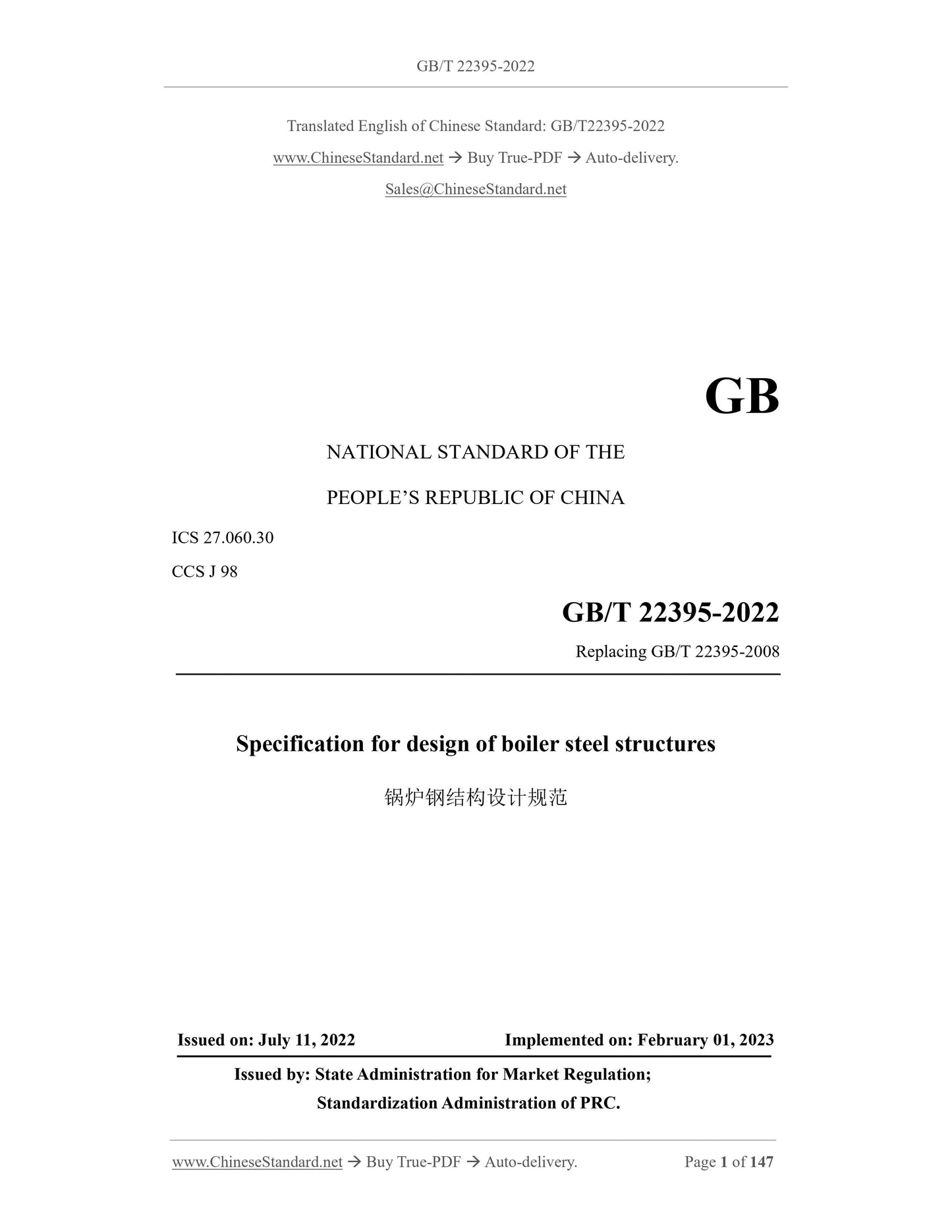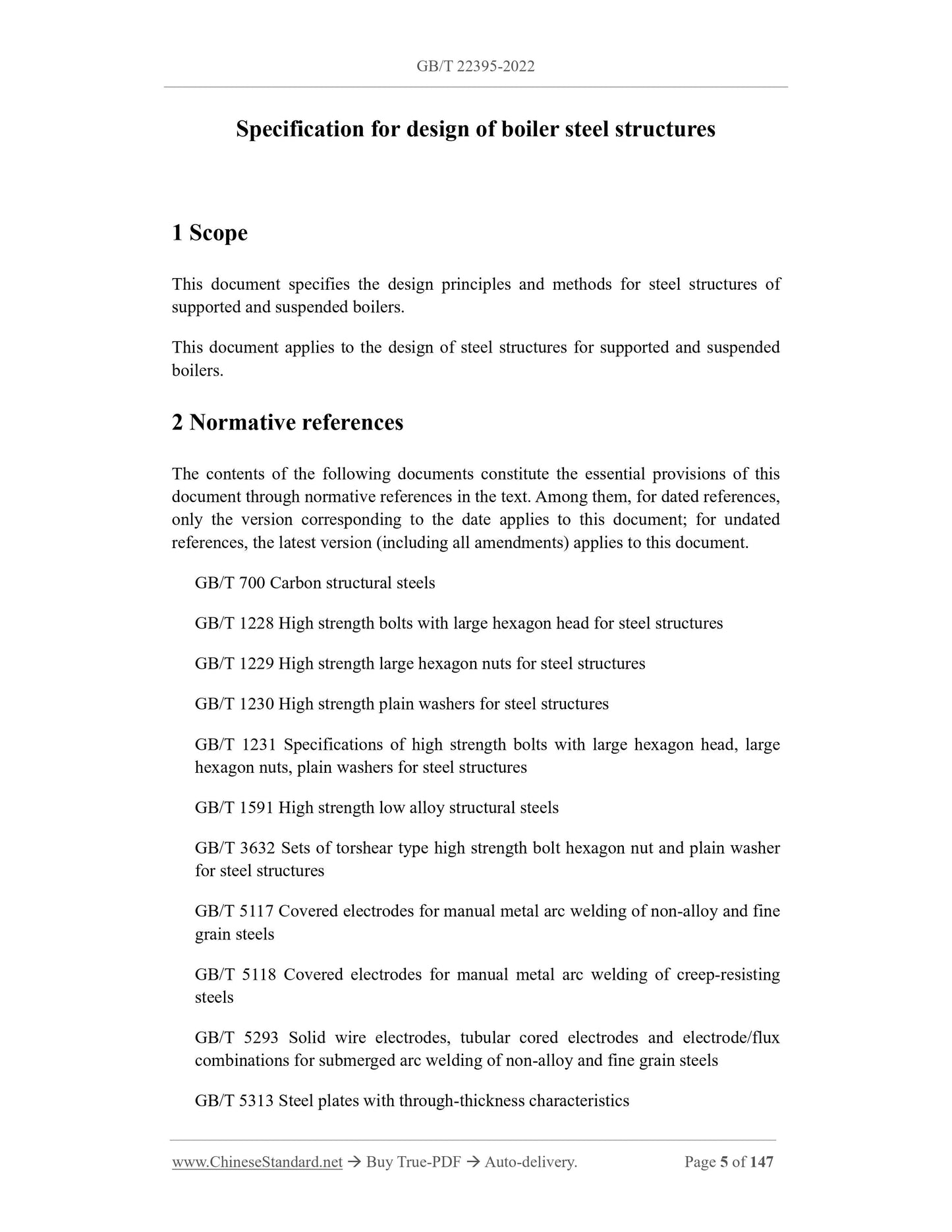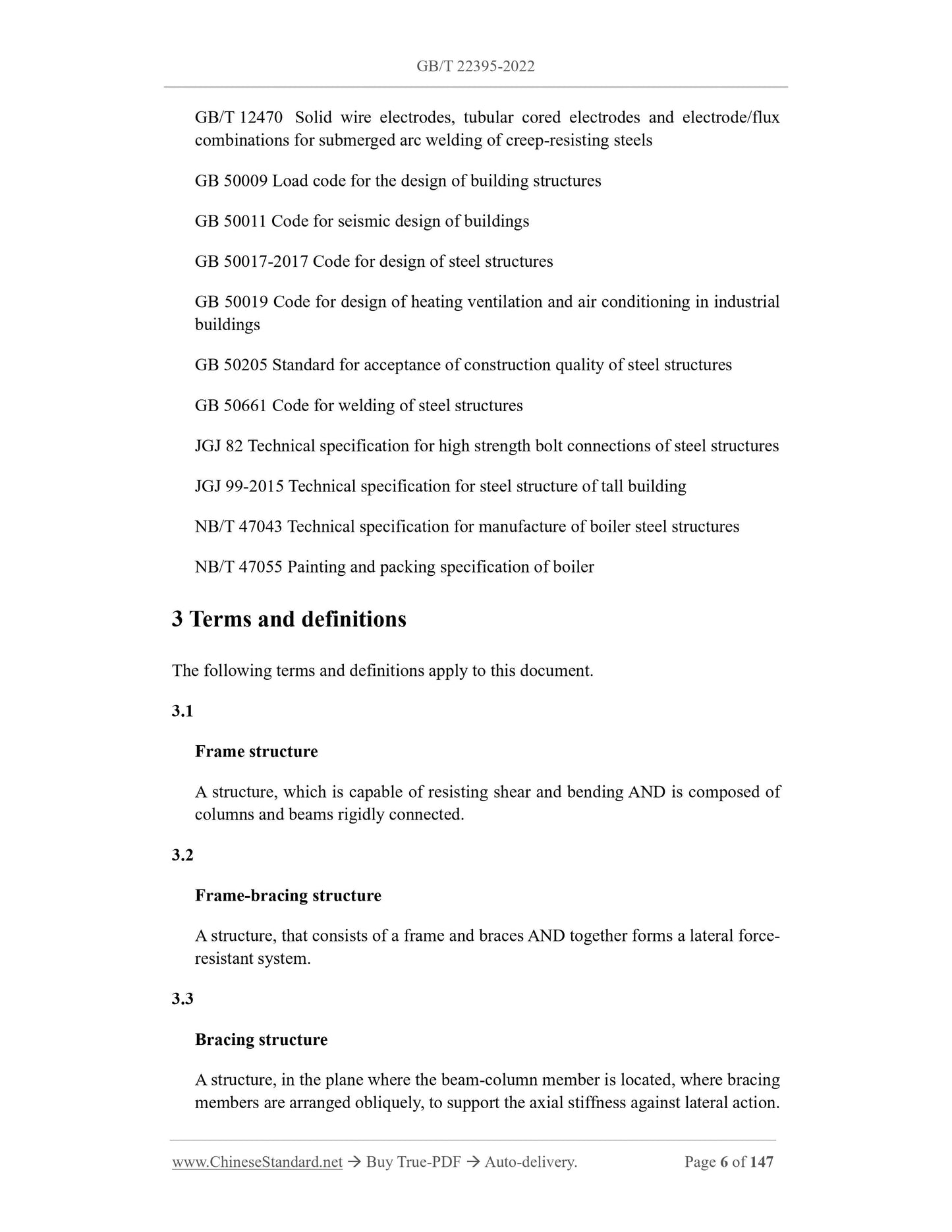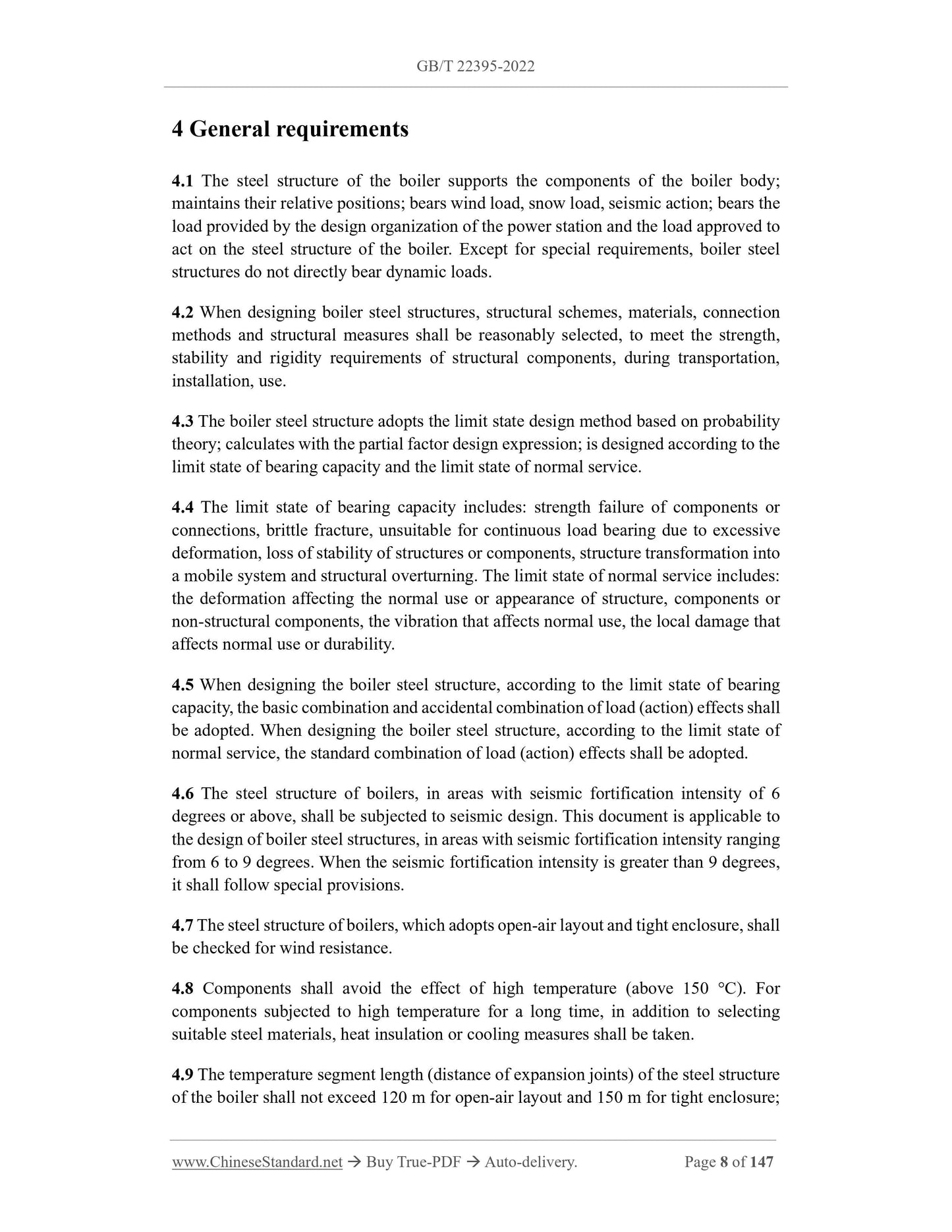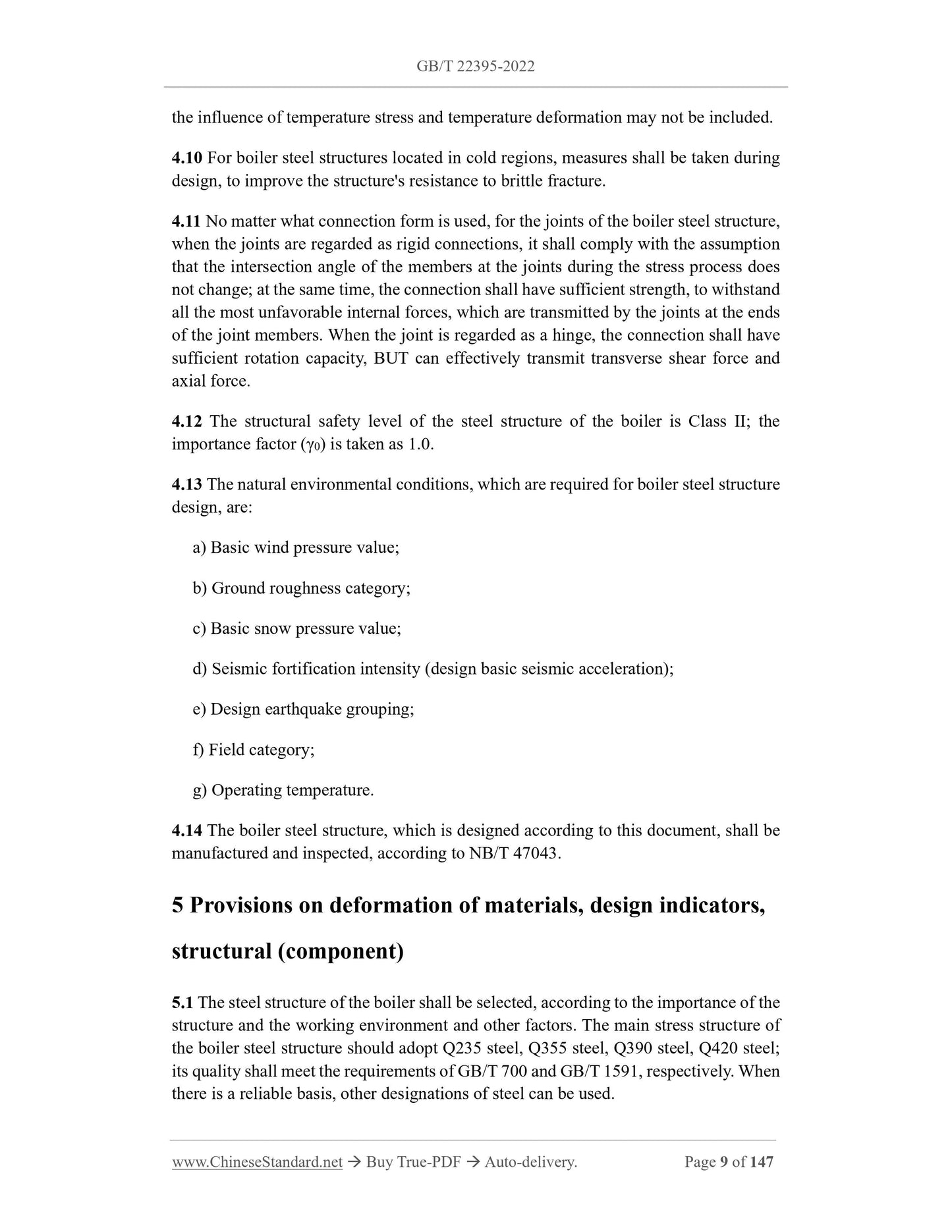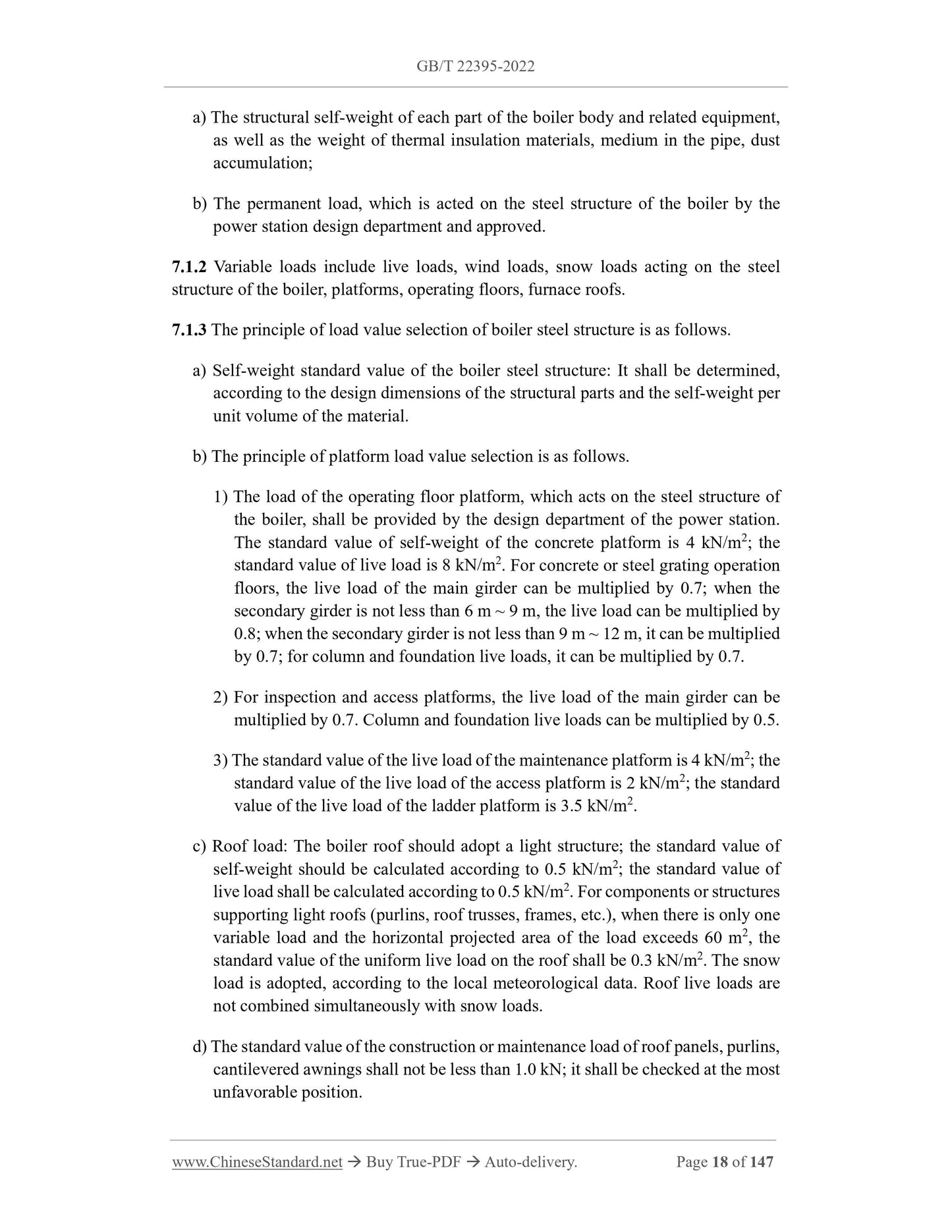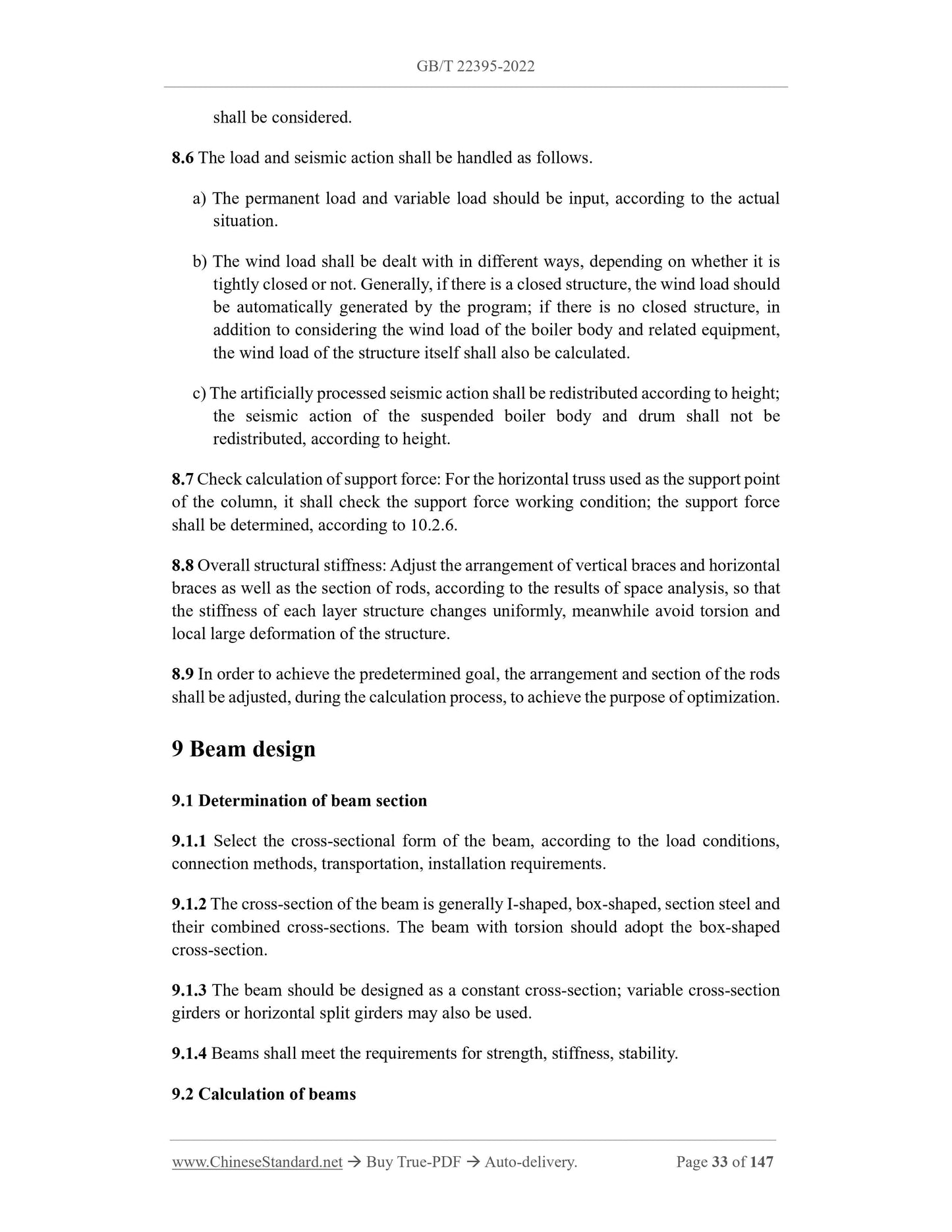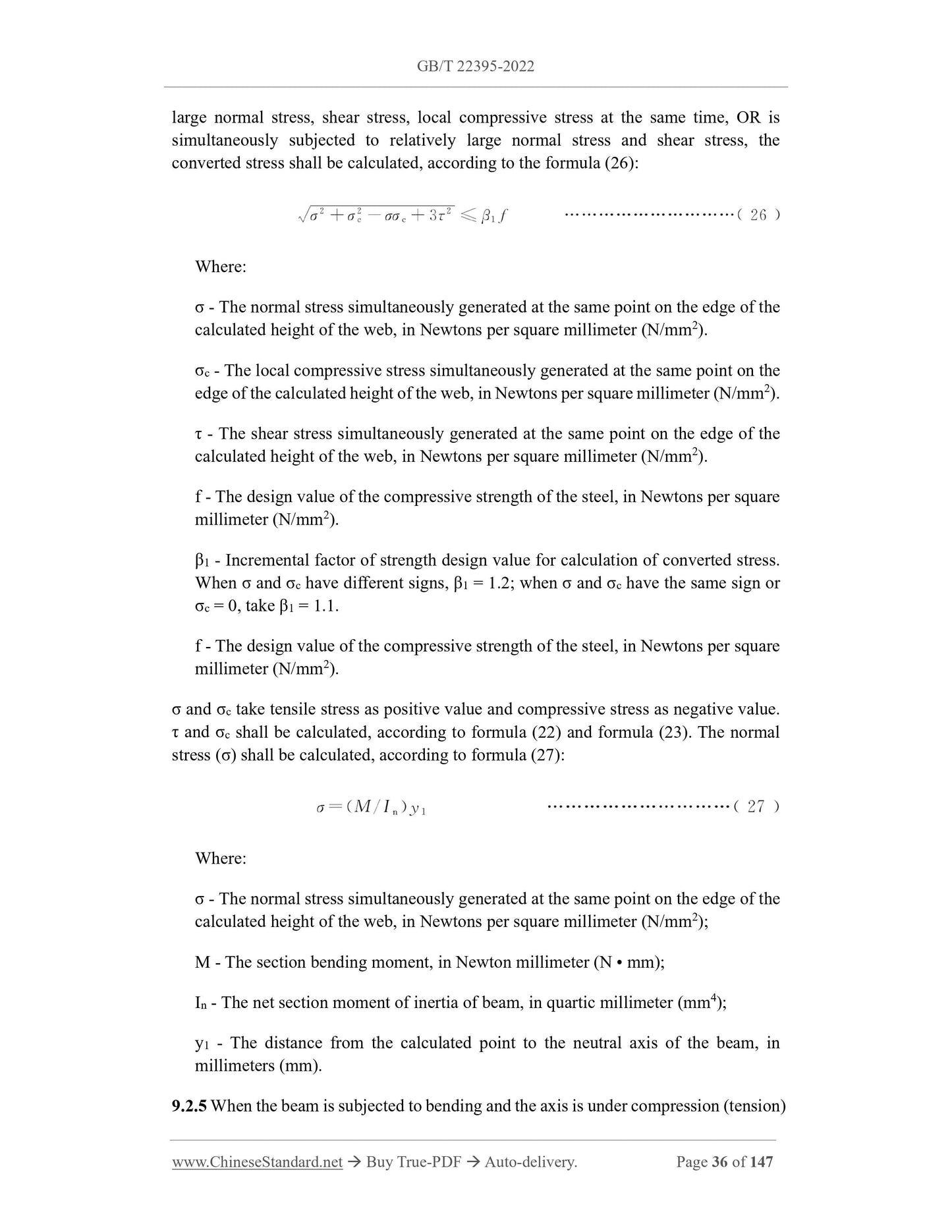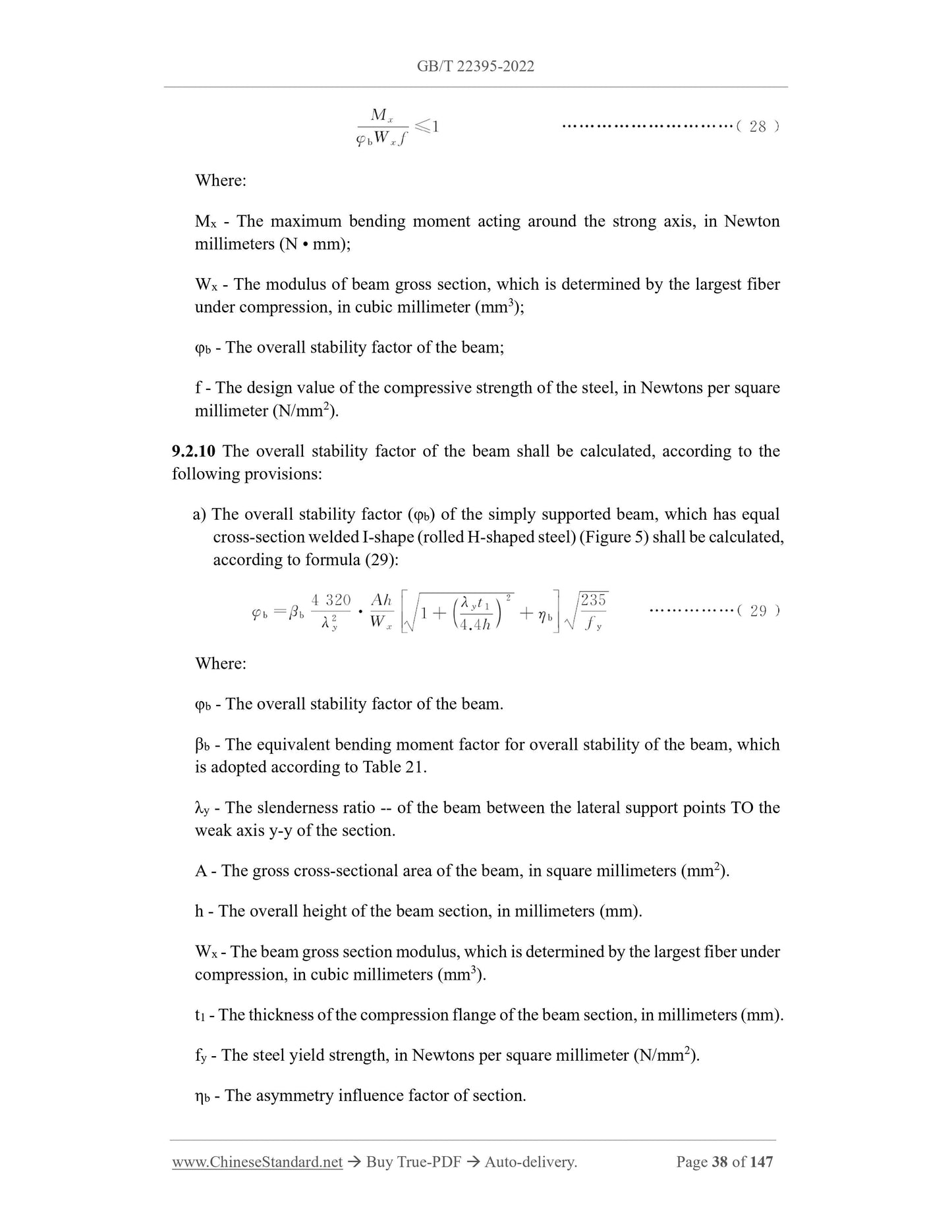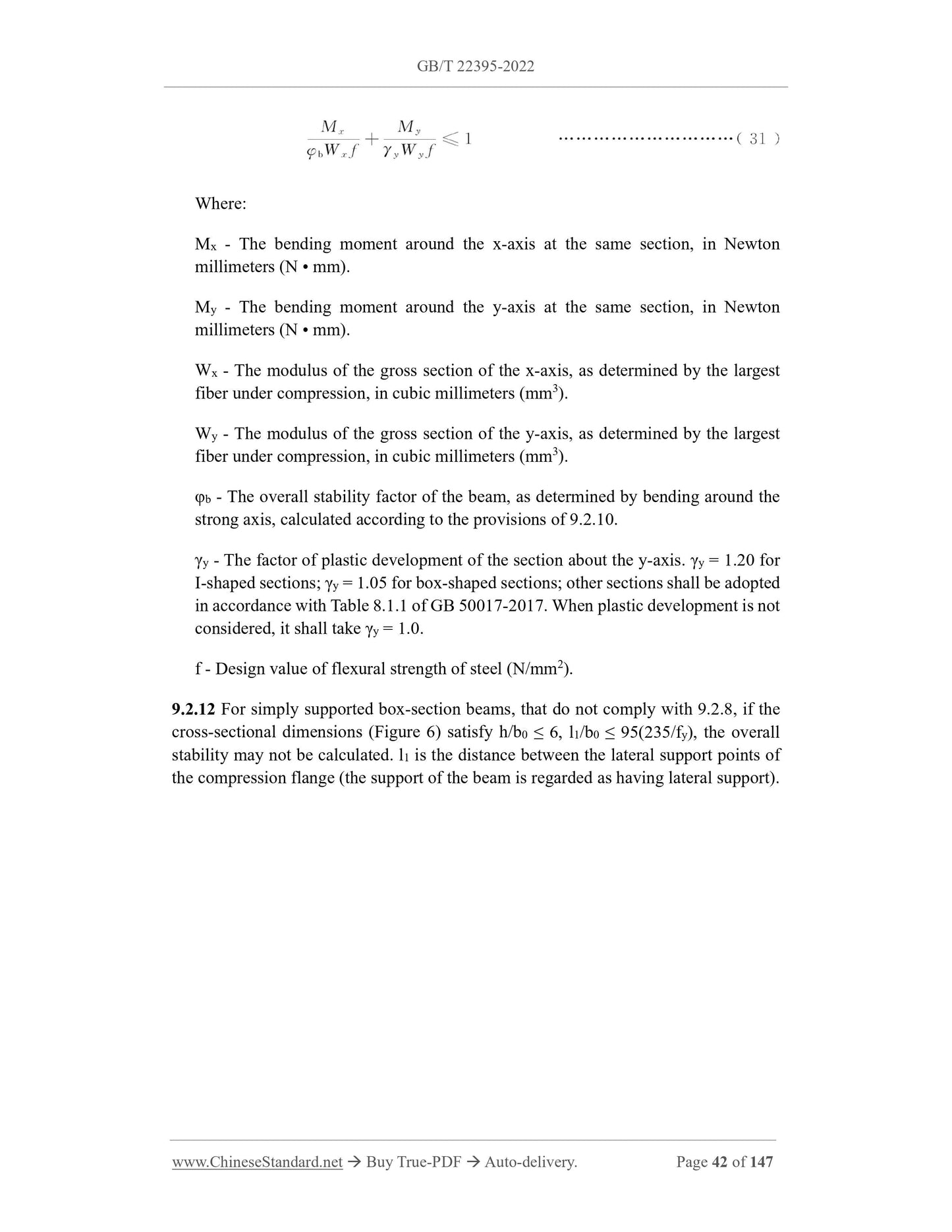1
/
of
12
www.ChineseStandard.us -- Field Test Asia Pte. Ltd.
GB/T 22395-2022 English PDF (GB/T22395-2022)
GB/T 22395-2022 English PDF (GB/T22395-2022)
Regular price
$995.00
Regular price
Sale price
$995.00
Unit price
/
per
Shipping calculated at checkout.
Couldn't load pickup availability
GB/T 22395-2022: Specification for design of boiler steel structures
Delivery: 9 seconds. Download (& Email) true-PDF + Invoice.
Get Quotation: Click GB/T 22395-2022 (Self-service in 1-minute)
Historical versions (Master-website): GB/T 22395-2022
Preview True-PDF (Reload/Scroll-down if blank)
GB/T 22395-2022
GB
NATIONAL STANDARD OF THE
PEOPLE’S REPUBLIC OF CHINA
ICS 27.060.30
CCS J 98
Replacing GB/T 22395-2008
Specification for design of boiler steel structures
ISSUED ON: JULY 11, 2022
IMPLEMENTED ON: FEBRUARY 01, 2023
Issued by: State Administration for Market Regulation;
Standardization Administration of PRC.
Table of Contents
Foreword ... 3
1 Scope ... 5
2 Normative references ... 5
3 Terms and definitions ... 6
4 General requirements ... 8
5 Provisions on deformation of materials, design indicators, structural (component) .. 9
6 Arrangement of boiler steel structure ... 15
7 Actions and combinations of effects ... 17
8 Structural analysis ... 32
9 Beam design ... 33
10 Column design ... 57
11 Design of support system ... 97
12 Connection design ... 104
13 Check calculation of seismic bearing capacity of connection joints of boiler steel
structure and seismic construction measures ... 141
14 Anti-rust and anti-corrosion treatment of boiler steel structure ... 147
Specification for design of boiler steel structures
1 Scope
This document specifies the design principles and methods for steel structures of
supported and suspended boilers.
This document applies to the design of steel structures for supported and suspended
boilers.
2 Normative references
The contents of the following documents constitute the essential provisions of this
document through normative references in the text. Among them, for dated references,
only the version corresponding to the date applies to this document; for undated
references, the latest version (including all amendments) applies to this document.
GB/T 700 Carbon structural steels
GB/T 1228 High strength bolts with large hexagon head for steel structures
GB/T 1229 High strength large hexagon nuts for steel structures
GB/T 1230 High strength plain washers for steel structures
GB/T 1231 Specifications of high strength bolts with large hexagon head, large
hexagon nuts, plain washers for steel structures
GB/T 1591 High strength low alloy structural steels
GB/T 3632 Sets of torshear type high strength bolt hexagon nut and plain washer
for steel structures
GB/T 5117 Covered electrodes for manual metal arc welding of non-alloy and fine
grain steels
GB/T 5118 Covered electrodes for manual metal arc welding of creep-resisting
steels
GB/T 5293 Solid wire electrodes, tubular cored electrodes and electrode/flux
combinations for submerged arc welding of non-alloy and fine grain steels
GB/T 5313 Steel plates with through-thickness characteristics
GB/T 12470 Solid wire electrodes, tubular cored electrodes and electrode/flux
combinations for submerged arc welding of creep-resisting steels
GB 50009 Load code for the design of building structures
GB 50011 Code for seismic design of buildings
GB 50017-2017 Code for design of steel structures
GB 50019 Code for design of heating ventilation and air conditioning in industrial
buildings
GB 50205 Standard for acceptance of construction quality of steel structures
GB 50661 Code for welding of steel structures
JGJ 82 Technical specification for high strength bolt connections of steel structures
JGJ 99-2015 Technical specification for steel structure of tall building
NB/T 47043 Technical specification for manufacture of boiler steel structures
NB/T 47055 Painting and packing specification of boiler
3 Terms and definitions
The following terms and definitions apply to this document.
3.1
Frame structure
A structure, which is capable of resisting shear and bending AND is composed of
columns and beams rigidly connected.
3.2
Frame-bracing structure
A structure, that consists of a frame and braces AND together forms a lateral force-
resistant system.
3.3
Bracing structure
A structure, in the plane where the beam-column member is located, where bracing
members are arranged obliquely, to support the axial stiffness against lateral action.
4 General requirements
4.1 The steel structure of the boiler supports the components of the boiler body;
maintains their relative positions; bears wind load, snow load, seismic action; bears the
load provided by the design organization of the power station and the load approved to
act on the steel structure of the boiler. Except for special requirements, boiler steel
structures do not directly bear dynamic loads.
4.2 When designing boiler steel structures, structural schemes, materials, connection
methods and structural measures shall be reasonably selected, to meet the strength,
stability and rigidity requirements of structural components, during transportation,
installation, use.
4.3 The boiler steel structure adopts the limit state design method based on probability
theory; calculates with the partial factor design expression; is designed according to the
limit state of bearing capacity and the limit state of normal service.
4.4 The limit state of bearing capacity includes: strength failure of components or
connections, brittle fracture, unsuitable for continuous load bearing due to excessive
deformation, loss of stability of structures or components, structure transformation into
a mobile system and structural overturning. The limit state of normal service includes:
the deformation affecting the normal use or appearance of structure, components or
non-structural components, the vibration that affects normal use, the local damage that
affects normal use or durability.
4.5 When designing the boiler steel structure, according to the limit state of bearing
capacity, the basic combination and accidental combination of load (action) effects shall
be adopted. When designing the boiler steel structure, according to the limit state of
normal service, the standard combination of load (action) effects shall be adopted.
4.6 The steel structure of boilers, in areas with seismic fortification intensity of 6
degrees or above, shall be subjected to seismic design. This document is applicable to
the design of boiler steel structures, in areas with seismic fortification intensity ranging
from 6 to 9 degrees. When the seismic fortification intensity is greater than 9 degrees,
it shall follow special provisions.
4.7 The steel structure of boilers, which adopts open-air layout and tight enclosure, shall
be checked for wind resistance.
4.8 Components shall avoid the effect of high temperature (above 150 °C). For
components subjected to high temperature for a long time, in addition to selecting
suitable steel materials, heat insulation or cooling measures shall be taken.
4.9 The temperature segment length (distance of expansion joints) of the steel structure
of the boiler shall not exceed 120 m for open-air layout and 150 m for tight enclosure;
the influence of temperature stress and temperature deformation may not be included.
4.10 For boiler steel structures located in cold regions, measures shall be taken during
design, to improve the structure's resistance to brittle fracture.
4.11 No matter what connection form is used, for the joints of the boiler steel structure,
when the joints are regarded as rigid connections, it shall comply with the assumption
that the intersection angle of the members at the joints during the stress process does
not change; at the same time, the connection shall have sufficient strength, to withstand
all the most unfavorable internal forces, which are transmitted by the joints at the ends
of the joint members. When the joint is regarded as a hinge, the connection shall have
sufficient rotation capacity, BUT can effectively transmit transverse shear force and
axial force.
4.12 The structural safety level of the steel structure of the boiler is Class II; the
importance factor (γ0) is taken as 1.0.
4.13 The natural environmental conditions, which are required for boiler steel structure
design, are:
a) Basic wind pressure value;
b) Ground roughness category;
c) Basic snow pressure value;
d) Seismic fortification intensity (design basic seismic acceleration);
e) Design earthquake grouping;
f) Field category;
g) Operating temperature.
4.14 The boiler steel structure, which is designed according to this document, shall be
manufactured and inspected, according to NB/T 47043.
5 Provisions on deformation of materials, design indicators,
structural (component)
5.1 The steel structure of the boiler shall be selected, according to the importance of the
structure and the working environment and other factors. The main stress structure of
the boiler steel structure should adopt Q235 steel, Q355 steel, Q390 steel, Q420 steel;
its quality shall meet the requirements of GB/T 700 and GB/T 1591, respectively. When
there is a reliable basis, other designations of steel can be used.
a) The structural self-weight of each part of the boiler body and related equipment,
as well as the weight of thermal insulation materials, medium in the pipe, dust
accumulation;
b) The permanent load, which is acted on the steel structure of the boiler by the
power station design department and approved.
7.1.2 Variable loads include live loads, wind loads, snow loads acting on the steel
structure of the boiler, platforms, operating floors, furnace roofs.
7.1.3 The principle of load value selection of boiler steel structure is as follows.
a) Self-weight standard value of the boiler steel structure: It shall be determined,
according to the design dimensions of the structural parts and the self-weight per
unit volume of the material.
b) The principle of platform load value selection is as follows.
1) The load of the operating floor platform, which acts on the steel structure of
the boiler, shall be provided by the design department of the power station.
The standard value of self-weight of the concrete platform is 4 kN/m2; the
standard value of live load is 8 kN/m2. For concrete or steel grating operation
floors, the live load of the main girder can be multiplied by 0.7; when the
secondary girder is not less than 6 m ~ 9 m, the live load can be multiplied by
0.8; when the secondary girder is not less than 9 m ~ 12 m, it can be multiplied
by 0.7; for column and foundation live loads, it can be multiplied by 0.7.
2) For inspection and access platforms, the live load of the main girder can be
multiplied by 0.7. Column and foundation live loads can be multiplied by 0.5.
3) The standard value of the live load of the maintenance platform is 4 kN/m2; the
standard value of the live load of the access platform is 2 kN/m2; the standard
value of the live load of the ladder platform is 3.5 kN/m2.
c) Roof load: The boiler roof should adopt a light structure; the standard value of
self-weight should be calculated according to 0.5 kN/m2; the standard value of
live load shall be calculated according to 0.5 kN/m2. For components or structures
supporting light roofs (purlins, roof trusses, frames, etc.), when there is only one
variable load and the horizontal projected area of the load exceeds 60 m2, the
standard value of the uniform live load on the roof shall be 0.3 kN/m2. The snow
load is adopted, according to the local meteorological data. Roof live loads are
not combined simultaneously with snow loads.
d) The standard value of the construction or maintenance load of roof panels, purlins,
cantilevered awnings shall not be less than 1.0 kN; it shall be checked at the most
unfavorable position.
borne by each node of the boiler steel structure.
b) Boilers with guiding devices arranged in the open air: According to the standard
values of wind load at different heights and the wind-receiving area of the furnace
constrained by the guiding devices, calculate the wind loads, which are borne by
each guiding device and act on the corresponding positions of the boiler steel
structure. In addition to the boiler itself, other equipment (such as various pipes,
etc.) acting on the steel structure of the boiler shall be subjected to wind loads to
the corresponding positions. At this time, the wind load, which is borne by each
node of the boiler steel structure, shall be calculated according to the appropriate
wind receiving area.
7.3 Seismic action
7.3.1 For boiler steel structures that have undergone seismic fortification, when they
are affected by frequent earthquakes, that are lower than the seismic fortification
intensity of the local area, the main structure can continue to be used without damage
or repair. When affected by an earthquake, which is equivalent to the seismic
fortification intensity of the local area, it may be damaged; however, it can still be used
continuously after repair. It will not collapse or cause life-threatening serious damage,
when it is affected by a rare earthquake, that is higher than the seismic fortification
intensity in this area.
7.3.2 The seismic fortification intensity shall be determined, according to the
documents (maps), which are approved and issued by the state. It should use the basic
seismic intensity, which is determined by the China Earthquake Motion Parameter
Zoning Map.
7.3.3 The boiler steel structure of a power plant, which has a unit capacity of 300 MW
and above or a planned capacity of 800 MW and above, belongs to category B buildings;
others belong to category C buildings.
7.3.4 When the seismic fortification intensity is 6 degrees, except for the irregular and
relatively high boiler steel structures built in category IV fields, the calculation of
seismic action and the seismic check of sections may be exempted; however, the
requirements for relevant seismic measures shall be met.
For boiler steel structures, which have irregular seismic fortification intensity of 6
degrees and relatively high boiler structures built in category IV fields, as well as the
boiler steel structures of 7 degrees and above, they shall be subject to the internal force
and deformation analysis under frequent earthquakes.
The elastic-plastic deformation analysis, under rare seismic action, shall comply with
the provisions of GB 50011.
7.3.5 When the steel structure ...
Delivery: 9 seconds. Download (& Email) true-PDF + Invoice.
Get Quotation: Click GB/T 22395-2022 (Self-service in 1-minute)
Historical versions (Master-website): GB/T 22395-2022
Preview True-PDF (Reload/Scroll-down if blank)
GB/T 22395-2022
GB
NATIONAL STANDARD OF THE
PEOPLE’S REPUBLIC OF CHINA
ICS 27.060.30
CCS J 98
Replacing GB/T 22395-2008
Specification for design of boiler steel structures
ISSUED ON: JULY 11, 2022
IMPLEMENTED ON: FEBRUARY 01, 2023
Issued by: State Administration for Market Regulation;
Standardization Administration of PRC.
Table of Contents
Foreword ... 3
1 Scope ... 5
2 Normative references ... 5
3 Terms and definitions ... 6
4 General requirements ... 8
5 Provisions on deformation of materials, design indicators, structural (component) .. 9
6 Arrangement of boiler steel structure ... 15
7 Actions and combinations of effects ... 17
8 Structural analysis ... 32
9 Beam design ... 33
10 Column design ... 57
11 Design of support system ... 97
12 Connection design ... 104
13 Check calculation of seismic bearing capacity of connection joints of boiler steel
structure and seismic construction measures ... 141
14 Anti-rust and anti-corrosion treatment of boiler steel structure ... 147
Specification for design of boiler steel structures
1 Scope
This document specifies the design principles and methods for steel structures of
supported and suspended boilers.
This document applies to the design of steel structures for supported and suspended
boilers.
2 Normative references
The contents of the following documents constitute the essential provisions of this
document through normative references in the text. Among them, for dated references,
only the version corresponding to the date applies to this document; for undated
references, the latest version (including all amendments) applies to this document.
GB/T 700 Carbon structural steels
GB/T 1228 High strength bolts with large hexagon head for steel structures
GB/T 1229 High strength large hexagon nuts for steel structures
GB/T 1230 High strength plain washers for steel structures
GB/T 1231 Specifications of high strength bolts with large hexagon head, large
hexagon nuts, plain washers for steel structures
GB/T 1591 High strength low alloy structural steels
GB/T 3632 Sets of torshear type high strength bolt hexagon nut and plain washer
for steel structures
GB/T 5117 Covered electrodes for manual metal arc welding of non-alloy and fine
grain steels
GB/T 5118 Covered electrodes for manual metal arc welding of creep-resisting
steels
GB/T 5293 Solid wire electrodes, tubular cored electrodes and electrode/flux
combinations for submerged arc welding of non-alloy and fine grain steels
GB/T 5313 Steel plates with through-thickness characteristics
GB/T 12470 Solid wire electrodes, tubular cored electrodes and electrode/flux
combinations for submerged arc welding of creep-resisting steels
GB 50009 Load code for the design of building structures
GB 50011 Code for seismic design of buildings
GB 50017-2017 Code for design of steel structures
GB 50019 Code for design of heating ventilation and air conditioning in industrial
buildings
GB 50205 Standard for acceptance of construction quality of steel structures
GB 50661 Code for welding of steel structures
JGJ 82 Technical specification for high strength bolt connections of steel structures
JGJ 99-2015 Technical specification for steel structure of tall building
NB/T 47043 Technical specification for manufacture of boiler steel structures
NB/T 47055 Painting and packing specification of boiler
3 Terms and definitions
The following terms and definitions apply to this document.
3.1
Frame structure
A structure, which is capable of resisting shear and bending AND is composed of
columns and beams rigidly connected.
3.2
Frame-bracing structure
A structure, that consists of a frame and braces AND together forms a lateral force-
resistant system.
3.3
Bracing structure
A structure, in the plane where the beam-column member is located, where bracing
members are arranged obliquely, to support the axial stiffness against lateral action.
4 General requirements
4.1 The steel structure of the boiler supports the components of the boiler body;
maintains their relative positions; bears wind load, snow load, seismic action; bears the
load provided by the design organization of the power station and the load approved to
act on the steel structure of the boiler. Except for special requirements, boiler steel
structures do not directly bear dynamic loads.
4.2 When designing boiler steel structures, structural schemes, materials, connection
methods and structural measures shall be reasonably selected, to meet the strength,
stability and rigidity requirements of structural components, during transportation,
installation, use.
4.3 The boiler steel structure adopts the limit state design method based on probability
theory; calculates with the partial factor design expression; is designed according to the
limit state of bearing capacity and the limit state of normal service.
4.4 The limit state of bearing capacity includes: strength failure of components or
connections, brittle fracture, unsuitable for continuous load bearing due to excessive
deformation, loss of stability of structures or components, structure transformation into
a mobile system and structural overturning. The limit state of normal service includes:
the deformation affecting the normal use or appearance of structure, components or
non-structural components, the vibration that affects normal use, the local damage that
affects normal use or durability.
4.5 When designing the boiler steel structure, according to the limit state of bearing
capacity, the basic combination and accidental combination of load (action) effects shall
be adopted. When designing the boiler steel structure, according to the limit state of
normal service, the standard combination of load (action) effects shall be adopted.
4.6 The steel structure of boilers, in areas with seismic fortification intensity of 6
degrees or above, shall be subjected to seismic design. This document is applicable to
the design of boiler steel structures, in areas with seismic fortification intensity ranging
from 6 to 9 degrees. When the seismic fortification intensity is greater than 9 degrees,
it shall follow special provisions.
4.7 The steel structure of boilers, which adopts open-air layout and tight enclosure, shall
be checked for wind resistance.
4.8 Components shall avoid the effect of high temperature (above 150 °C). For
components subjected to high temperature for a long time, in addition to selecting
suitable steel materials, heat insulation or cooling measures shall be taken.
4.9 The temperature segment length (distance of expansion joints) of the steel structure
of the boiler shall not exceed 120 m for open-air layout and 150 m for tight enclosure;
the influence of temperature stress and temperature deformation may not be included.
4.10 For boiler steel structures located in cold regions, measures shall be taken during
design, to improve the structure's resistance to brittle fracture.
4.11 No matter what connection form is used, for the joints of the boiler steel structure,
when the joints are regarded as rigid connections, it shall comply with the assumption
that the intersection angle of the members at the joints during the stress process does
not change; at the same time, the connection shall have sufficient strength, to withstand
all the most unfavorable internal forces, which are transmitted by the joints at the ends
of the joint members. When the joint is regarded as a hinge, the connection shall have
sufficient rotation capacity, BUT can effectively transmit transverse shear force and
axial force.
4.12 The structural safety level of the steel structure of the boiler is Class II; the
importance factor (γ0) is taken as 1.0.
4.13 The natural environmental conditions, which are required for boiler steel structure
design, are:
a) Basic wind pressure value;
b) Ground roughness category;
c) Basic snow pressure value;
d) Seismic fortification intensity (design basic seismic acceleration);
e) Design earthquake grouping;
f) Field category;
g) Operating temperature.
4.14 The boiler steel structure, which is designed according to this document, shall be
manufactured and inspected, according to NB/T 47043.
5 Provisions on deformation of materials, design indicators,
structural (component)
5.1 The steel structure of the boiler shall be selected, according to the importance of the
structure and the working environment and other factors. The main stress structure of
the boiler steel structure should adopt Q235 steel, Q355 steel, Q390 steel, Q420 steel;
its quality shall meet the requirements of GB/T 700 and GB/T 1591, respectively. When
there is a reliable basis, other designations of steel can be used.
a) The structural self-weight of each part of the boiler body and related equipment,
as well as the weight of thermal insulation materials, medium in the pipe, dust
accumulation;
b) The permanent load, which is acted on the steel structure of the boiler by the
power station design department and approved.
7.1.2 Variable loads include live loads, wind loads, snow loads acting on the steel
structure of the boiler, platforms, operating floors, furnace roofs.
7.1.3 The principle of load value selection of boiler steel structure is as follows.
a) Self-weight standard value of the boiler steel structure: It shall be determined,
according to the design dimensions of the structural parts and the self-weight per
unit volume of the material.
b) The principle of platform load value selection is as follows.
1) The load of the operating floor platform, which acts on the steel structure of
the boiler, shall be provided by the design department of the power station.
The standard value of self-weight of the concrete platform is 4 kN/m2; the
standard value of live load is 8 kN/m2. For concrete or steel grating operation
floors, the live load of the main girder can be multiplied by 0.7; when the
secondary girder is not less than 6 m ~ 9 m, the live load can be multiplied by
0.8; when the secondary girder is not less than 9 m ~ 12 m, it can be multiplied
by 0.7; for column and foundation live loads, it can be multiplied by 0.7.
2) For inspection and access platforms, the live load of the main girder can be
multiplied by 0.7. Column and foundation live loads can be multiplied by 0.5.
3) The standard value of the live load of the maintenance platform is 4 kN/m2; the
standard value of the live load of the access platform is 2 kN/m2; the standard
value of the live load of the ladder platform is 3.5 kN/m2.
c) Roof load: The boiler roof should adopt a light structure; the standard value of
self-weight should be calculated according to 0.5 kN/m2; the standard value of
live load shall be calculated according to 0.5 kN/m2. For components or structures
supporting light roofs (purlins, roof trusses, frames, etc.), when there is only one
variable load and the horizontal projected area of the load exceeds 60 m2, the
standard value of the uniform live load on the roof shall be 0.3 kN/m2. The snow
load is adopted, according to the local meteorological data. Roof live loads are
not combined simultaneously with snow loads.
d) The standard value of the construction or maintenance load of roof panels, purlins,
cantilevered awnings shall not be less than 1.0 kN; it shall be checked at the most
unfavorable position.
borne by each node of the boiler steel structure.
b) Boilers with guiding devices arranged in the open air: According to the standard
values of wind load at different heights and the wind-receiving area of the furnace
constrained by the guiding devices, calculate the wind loads, which are borne by
each guiding device and act on the corresponding positions of the boiler steel
structure. In addition to the boiler itself, other equipment (such as various pipes,
etc.) acting on the steel structure of the boiler shall be subjected to wind loads to
the corresponding positions. At this time, the wind load, which is borne by each
node of the boiler steel structure, shall be calculated according to the appropriate
wind receiving area.
7.3 Seismic action
7.3.1 For boiler steel structures that have undergone seismic fortification, when they
are affected by frequent earthquakes, that are lower than the seismic fortification
intensity of the local area, the main structure can continue to be used without damage
or repair. When affected by an earthquake, which is equivalent to the seismic
fortification intensity of the local area, it may be damaged; however, it can still be used
continuously after repair. It will not collapse or cause life-threatening serious damage,
when it is affected by a rare earthquake, that is higher than the seismic fortification
intensity in this area.
7.3.2 The seismic fortification intensity shall be determined, according to the
documents (maps), which are approved and issued by the state. It should use the basic
seismic intensity, which is determined by the China Earthquake Motion Parameter
Zoning Map.
7.3.3 The boiler steel structure of a power plant, which has a unit capacity of 300 MW
and above or a planned capacity of 800 MW and above, belongs to category B buildings;
others belong to category C buildings.
7.3.4 When the seismic fortification intensity is 6 degrees, except for the irregular and
relatively high boiler steel structures built in category IV fields, the calculation of
seismic action and the seismic check of sections may be exempted; however, the
requirements for relevant seismic measures shall be met.
For boiler steel structures, which have irregular seismic fortification intensity of 6
degrees and relatively high boiler structures built in category IV fields, as well as the
boiler steel structures of 7 degrees and above, they shall be subject to the internal force
and deformation analysis under frequent earthquakes.
The elastic-plastic deformation analysis, under rare seismic action, shall comply with
the provisions of GB 50011.
7.3.5 When the steel structure ...
Share
